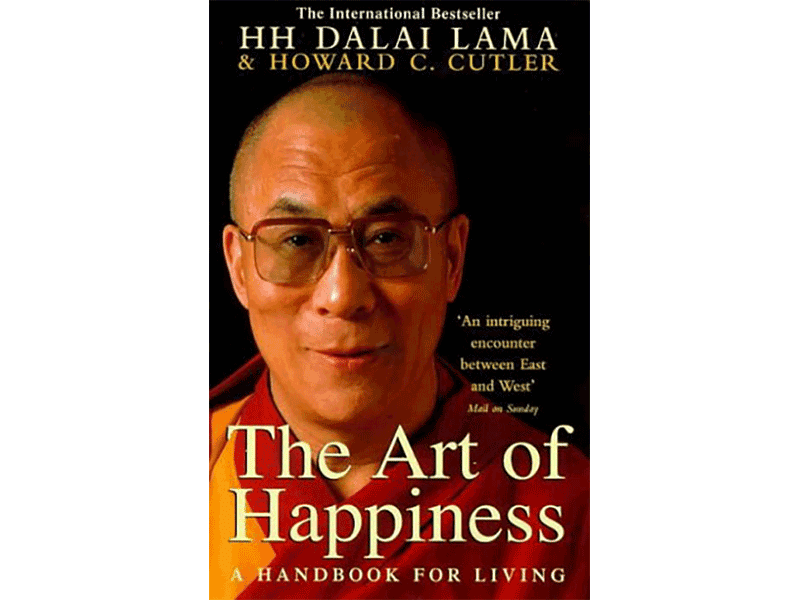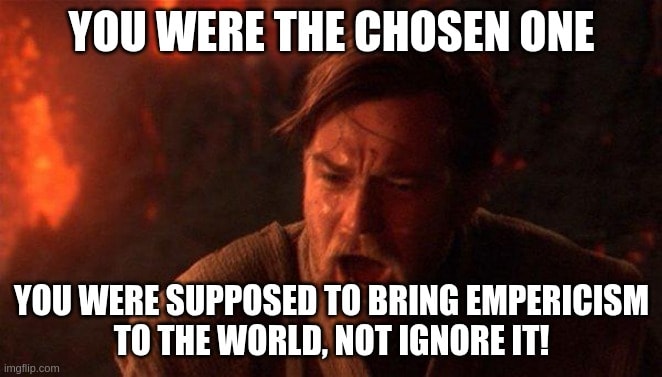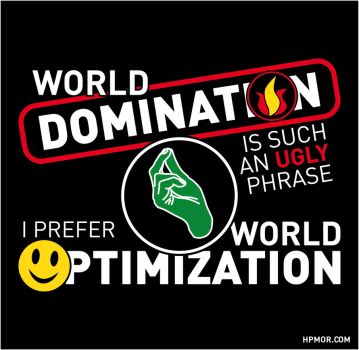Published on May 17, 2025 4:56 AM GMT
The Art of Happiness is a book co-written by American psychiatrist Dr. Cutler and the 14th Dalai Lama, Tenzin Gyatso. Published in 1998, the book is an attempt to blend western scientific understanding of the mind with the spiritual wisdom and ancient training of Buddhist practices. Success would mean a book that taught you how to be happy.
This is a terrific idea. All over the world, some human beings are unhappy. If you’re not sure this is true, go walk down your office or knock on a few doors in your neighborhood and ask. Some of us are happy, but many of us just wound up that way by luck or circumstance, or sometimes by specific application of effort to solving our personal problems. Obviously it’s worth someone working really hard to figure out how to become happy and then writing down how to do it in a book sold around the world.
If you were going to have someone write a book like that, who else would you choose? There are many ancient traditions of wisdom, but Buddhism is unusually attentive to the whole suffering and joy thing. We’re not going to ask the Calvinists for lessons on enjoying life. But the stereotype of deep religious wisdom is that it’s wrapped in impossible koans, so a western scientist should be able to put things into simple diagnoses and understandable steps for a western audience.
My copy of the 10th Anniversary Edition has, in the introduction, the following line: “we can train in happiness in much the same way that we train in any other skill.” That’s the premise of the book. How well does it execute on that premise? Better than I’d expected, but not as well as I’d hoped, and best summed up with a line from the regular introduction: “I felt that, using my background in psychiatry, I could codify his views into a set of easy instructions on how to conduct one’s daily life. By the end of our series of meetings I had given up on that idea.”
Not a strong start.

I: The Purpose of Life
Part of the obstacle preventing people from being happy is that most of them don’t even try.
That seems unduly pessimistic, but Dr. Cutler points out that happiness is not usually a therapeutic objective. The alleviation of depression is! Mitigating anxiety is! So are any other number of goals where you’re trying to fix some specific flaw or issue. However, being unhappy is not diagnosable in the DSM-V, with a sort of unstated assumption that once all the flaws and issues are removed, people will inevitably become happy. This doesn’t fit our observations about ourselves or the people around us however. Some people manage to be cheerful in spite of a wealth of setbacks and burdens.
So what does bring happiness, if not an absence of anything wrong with you? The Dalai Lama suggests that you can achieve happiness for a while if you get all the things you want, but that this is fickle and hard to hold on to. If you want a nice car, and you get the car, then you might be happy as long as nothing happens to the car and you can still make the car payment. If you can’t, then you’re no longer happy. If, instead, you learn to be content with whatever you have even if whatever you have is nothing, then it’s not like the bank is going to repossess your nothing for failure to pay your nothing loan.
This felt a bit like assuming that once all the flaws and issues are accepted, then people will inevitably become happy.
Throughout the book, Dr. Cutler brings up numerous examples of people he meets or patients he treats. These examples are illustrative, often brought up to fit the lesson of that subchapter, but I didn’t find the examples convincing. After all, the good doctor gets to pick his examples from a long career of treating patients, showing us the details that fit the lesson he’s trying to teach. They’re good as parables, but this is exactly the kind of thing that the phrase “the plural of anecdote is not data” is meant to address.
This section of the book also points out the distinction between happiness and pleasure. If pleasure is the momentary impulse of joy, the drenching of the mind in happy chemicals because of a sweet snack or an instant of victory over another, then happiness is. . . less well defined, really.

The example given here is of a professional woman torn between doing personally rewarding work in a big city she hates, or doing work that she doesn’t care about in a small town that she loves. After agonizing over the decision, Dr. Cutler asks her if the work she doesn’t care about would bring her happiness, and she decides that no, it wouldn’t, so she stays in the big city. Thus is another victory won by deliberate thinking and asking extremely basic questions.
That last sentence was snark, but underneath the snark I have a lot of respect for Dr. Cutler’s role here. Often it seems to me that people genuinely fail to actually ask themselves the actual question, and that they can make an attempt at answering it only once the question is asked. Too many people simply didn’t think about it, or if they did it was for a minute or two in high school when the guidance counselor asked what they wanted to major in.
His clients are there because something isn’t working, and by bringing up the question of what makes them happy he’s doing a valuable service. One takeaway from reading this book, if you didn’t already do it, is to ask yourself whether what you’re doing will bring you happiness.
Actually, why not make that a takeaway from reading this review? Go take five minutes, I’ll still be here when you get back.
II: Human Warmth and Compassion
A major part of the thesis of the Dalai Lama’s approach seems to be that having compassion for others is one of the best routes to being happy. Unhappily, this is the part of the book that I find I disagree with the most.
To be clear, the Buddhist notion of compassion seems to be a very specific experience. From the descriptions, it’s about empathizing with the people around you, and with People in the abstract. Serving others, putting yourself in their shoes, and generally getting out of your own head are taken as steps along the path to being connected to the great web of humanity and therefore being happy.
Some of this was at the end of Part One, but throughout Part Two I found myself annoyed about two kinds of people Dr. Cutler and the Dalai Lama seemed to fail to empathize with at all.
The first kind of people are the ones the Dalai Lama seems to fail to empathize with. It seems like he has very poor empathy (or at least theory of mind) for anyone who doesn’t have empathy for others. Psychopaths, narcissists, or just folks out on the odd end of the bell curve, if I’m reading this right the Dalai Lama seems to think they would have a lot less joy. The strong form of the book’s statements seems to be that people like that cannot be happy.
While venturing a guess as to what is in another person’s head is always a fraught endeavor, I think I’ve met some people who were extreme outliers in how little they empathized with others, and on the whole I think they weren’t much more or less happy than other people I saw around me. Sometimes this is because these people are successful at obtaining a steady supply of the pleasures of life. Other times this is because feeling the emotions of others sucks.
Let's go into that in more detail. I’m actually confused what the Dalai Lama is doing when he empathizes with, say, a woman whose only child has recently died. That doesn’t sound like a pleasant place to be in. The woman is clearly not happy. So when you expand your own compassion to cover her, and try to put yourself in her shoes and feel her suffering. . . doesn’t that feel bad? Having a profound sense of connection for the hurting and helpless millions of the world seems like it should really ruin your day. But, no, something about the way he claims to take on the suffering of others voluntarily strips it of the worst of the pain.
The second kind of people are the ones Dr. Cutler lacks compassion for, and that’s anyone who tries to look up any of the studies he references. Seriously, I assumed part of the point of having the Western Man Of Modern Medicine as one of the two co-authors here was that we could properly do a tiny bit of science to the claims of ancient Buddhist tradition, or at least notice which scientific claims backed Buddhism up and which disagreed with Buddhism.
But no, he’ll use a statement like “Over the past two or three decades, there have been literally hundreds of scientific studies indicating that…” or “Confirmed by a number of recent studies…” Sometimes he’ll give the authors of a specific study, but usually he just says the studies exist. That doesn’t count! This is Freshman English Class level stuff! You have to cite a specific study or it doesn't count!
I also want to call out an interesting anecdote of Dr. Cutler’s. He’s been frustrated and unhappy about something in his own personal life, when a chance conversation with a friend he’s been talking to about all this research he’s done with the Dalai Lama makes him focus on a particular lesson that’s apt to the trouble he’s been having.
“Until that moment, however, somehow it hadn’t occurred to me to apply his ideals fully to my own life, at least not right now - I always had a vague intention of trying to implement his ideas in my life at some point in the future, perhaps when I had more time.”
I completely believe this happened and this is how people work, but I also almost choked with laughter at how on point this is.
C’mon! You sought out the person you thought was the world’s expert on living a good life, arranged to ask them questions about the subject for hours, and it hadn’t occurred to you to apply the ideals to your own life? You just had a vague intention of trying to implement the ideas at some fuzzy future date?

This would be merely funny, and not a stark reminder, if I hadn’t made mistakes that feel that bad myself.
For all my disagreement and humor, this is the part of the book that started to get into more specific techniques. For instance, when you’re trying to connect with someone, start with the things you have in common. You are both human, for instance. You might both be tired, and you can be sure that you both want to be happy and don’t want to suffer. It’s good advice, and while there isn’t as much of it as specific as I’d like, what is there is simple and clearly written. No zen koans about one hand clapping here.
III: Transforming Suffering
The third part of the book is about specific techniques to take a moment of suffering and turn that pain into something else. I found it to be the best part of the book. If this review almost convinces you to read The Art Of Happiness, but you’re maybe not sold on reading an entire book, I suggest you read only part three.
As a rationalist, this was also the part of the book where I most often felt surprised at where Buddhist thought seemed to have arrived at a concept I thought of as a rationalist one. Take the following (somewhat abbreviated) paragraphs.
“Let's say that someone makes you angry. . . In a lot of cases, it’s not just a matter of getting angry at the time you’re being hurt. You might think about the event later, and every time you think about it you become angry all over again.
Surely the person who caused this anger in you will have a lot of other positive aspects, positive qualities. If you look carefully, you will also find that the act which has made you angry has also given you certain opportunities, something which otherwise would not have been possible, even from your point of view. . .
But what about if you look for the positive angles of a person or event and can’t find any?
Here, I think, we would be dealing with a situation where you might need to make some effort. . . but this perception does not correspond with reality.”
Or in our language, your enemies are not innately evil.
There’s a charming story about being on a long, frustrating plane flight surrounded by obnoxious neighbors who at first glance are entirely awful. Yet, as Dr. Cutler focuses on a neighbor’s fingernail, he finds there isn’t anything really wrong with that fingernail. Well, how about the rest of the finger? No, taken in isolation there isn’t anything bad about the finger. What about the next finger then, or the next one?
Thus does he work through more and more of this person he had been supremely irritated at, decomposing them into smaller segments until he finds the level of resolution at which he can’t find anything wrong with them. This arrangement of a technique description, a parable about what it feels like to use, and an intended result is easy for me to follow, and this one seems to work for me except when I decompose this book looking for citations and then I'm still irritated beyond all reason.
As I am mentioning the parts where it seems like rationality and The Art of Happiness agree however, I just want to point at one more quote.
“For example, reflecting on your suffering can reduce your arrogance, your feeling of conceit. Of course, he laughed heartily, this may not be seen as a practical benefit or be a convincing reason for someone who doesn’t consider arrogance or pride to be a fault."
Guilty as charged your honor.

IV: Overcoming Obstacles
The first obstacle is our natural inclination to continue with the habits we are accustomed to. Changing those habits is slow but steady work, but once the better habit is in place, all the strength and power of complacency is on your side. That’s why you want to bring about specific changes with focus and deliberation. None of that is surprising to me, but I can imagine someone reading this before hearing the idea from somewhere else and finding it more insightful.
Hidden in this subsection however, there’s another rationalist comparison I want to make. Towards the start of part four, there’s a fragment of poem that resonated with me.
As long as space endures
As long as sentient beings remain
May I too live
To dispel the miseries
I cannot explain without reaching for metaphor and intuition why, but it feels like one half of a pair with
Even if the stars should die in heaven
Our sins can never be undone
No single death will be forgiven
When fades at last the last lit sun.

The bulk of part four is largely focused on anger, hatred, anxiety, and self-doubt. Of these, anger is the one I have the most trouble with, and I found the advice an interesting frame. Instead of getting angry and lashing out (which, yes, I know is unhelpful) the advice is about the strength involved in simply standing firm with where you are. Don’t lunge forward, simply remain patient and restrained.
I do think it’s good advice, but it’s the kind of thing that takes slow, steady practice to get right. I find it too easy to be patient for a little longer than I used to, but not infinitely patient, and I didn’t come away with an idea of how keeping myself planted in my conviction or firm in my resolve changed things enough to get whatever is pissing me off to go the hell away and stop bothering me for one fucking minute. Still, uh, the direction of the advice seems spot on.
V: Closing Reflections on Leading a Spiritual Life
For a book about the head of a religion, there’s surprisingly little about the spiritual aspects of Buddhism. This is to the strength of the book I think. Both Dr. Cutler and the Dalai Lama seem to agree that you don’t have to be a Buddhist to use the techniques found in the book, and neither seems interested in converting the reader to Buddhism. This is the shortest part of the book, and it mostly describes how the Dalai Lama came to these conclusions. It’s fine, and someone who benefits from meditation practices more than I do might enjoy the descriptions of those.
One line I want to pick out and talk about because it caught me by surprise is about prayer.
“I think prayer is, for the most part, a simple daily reminder of your deeply held principles and convictions.”
Despite growing up religious, and even having a habit of daily prayer that persists to this day, I had not thought of prayer this way. For me prayer has always been a conversation, albeit one where my interlocutor doesn’t speak so much as listen well. Having read that line however, it’s changed how I think about these conversations. After having read the book, I’ve been trying to keep more continuity in my prayers. I don’t just talk over the day and what I want from tomorrow, but now I try to recite what I want to be and look at where I’m falling short and where I’m proud of myself for living up to what I hope to be.
Speaking of experimentation, apparently Buddhism is a fairly practical religion. When talking about other faiths, the Dalai Lama says:
“Through this kind of closer contact we can learn about the useful contributions that these religions have made to humanity and find useful aspects of the other traditions that we can learn from. We may even discover methods and techniques that we can adopt in our own practice.”
I got the impression from reading this book that Dr. Cutler wasn’t just learning from the Dalai Lama; that the Dalai Lama was learning from Dr. Cutler. It seemed that the man who held the highest religious office in Buddhism was interested to find out what the western world could tell him about happiness. If I have described more of the Buddhist side of this book, it is largely because of my own frustrations with the science that Dr. Cutler references being so maddeningly under-specified. I’ve seen more citations given out by a Sunday afternoon street parking attendant than I’ve seen in this book.
Overall, I’m glad I read this book. I think it’s a reasonable attempt at laying out a guide for people looking to live happier lives, and while I personally would have preferred more detail and documented steps with numbered lists and indented bullet points, I understand that there are a lot of circumstances that can come up and it would be an endless task to try and give precise instructions for each one.
If I was going to offer some suggestions for improvements, it would be to have a third person in the mix between psychiatrist and monk. Both seem to be capable communicators, but they might have benefited from someone who was a newcomer to both fields to ask them each questions about the underlying mechanisms, trying to lay out the model with all its gears and component building blocks neatly labeled.
Or perhaps that’s a need which I cannot satisfy, whose lack makes me unhappy, and I should learn to be content with the book I have.
Discuss

